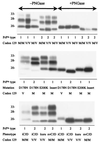Genetic influence on the structural variations of the abnormal prion protein
- PMID: 10963679
- PMCID: PMC27779
- DOI: 10.1073/pnas.97.18.10168
Genetic influence on the structural variations of the abnormal prion protein
Abstract
Prion diseases are characterized by the presence of the abnormal prion protein PrP(Sc), which is believed to be generated by the conversion of the alpha-helical structure that predominates in the normal PrP isoform into a beta-sheet structure resistant to proteinase K (PK). In human prion diseases, two major types of PrP(Sc), type 1 and 2, can be distinguished based on the difference in electrophoretic migration of the PK-resistant core fragment. In this study, protein sequencing was used to identify the PK cleavage sites of PrP(Sc) in 36 cases of prion diseases. We demonstrated two primary cleavage sites at residue 82 and residue 97 for type 1 and type 2 PrP(Sc), respectively, and numerous secondary cleavages distributed along the region spanning residues 74-102. Accordingly, we identify three regions in PrP(Sc): one N-terminal (residues 23-73) that is invariably PK-sensitive, one C-terminal (residues 103-231) that is invariably PK-resistant, and a third variable region (residues 74-102) where the site of the PK cleavage, likely reflecting the extent of the beta-sheet structure, varies mostly as a function of the PrP genotype at codon 129.
Figures



References
-
- Parchi P, Gambetti P. Curr Opin Neurol. 1995;8:286–293. - PubMed
-
- Bruce M E, Will R G, Ironside J W, McConnell I, Drummond D, Suttie A, McCardle L, Chree A, Hope J, Birkett C, et al. Nature (London) 1997;389:498–501. - PubMed
-
- Bruce M E, McConnell I, Fraser H, Dickinson A G. J Gen Virol. 1991;72:595–603. - PubMed
Publication types
MeSH terms
Substances
Grants and funding
LinkOut - more resources
Full Text Sources
Other Literature Sources
Medical
Research Materials

